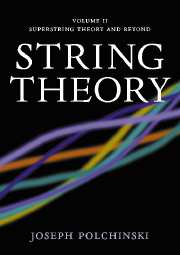Book contents
- Frontmatter
- Contents
- Foreword
- Preface
- Notation
- 10 Type I and type II superstrings
- 11 The heterotic string
- 12 Superstring interactions
- 13 D-branes
- 14 Strings at strong coupling
- 15 Advanced CFT
- 16 Orbifolds
- 17 Calabi–Yau compactification
- 18 Physics in four dimensions
- 19 Advanced topics
- Appendix B Spinors and SUSY in various dimensions
- References
- Glossary
- Index
13 - D-branes
Published online by Cambridge University Press: 26 February 2010
- Frontmatter
- Contents
- Foreword
- Preface
- Notation
- 10 Type I and type II superstrings
- 11 The heterotic string
- 12 Superstring interactions
- 13 D-branes
- 14 Strings at strong coupling
- 15 Advanced CFT
- 16 Orbifolds
- 17 Calabi–Yau compactification
- 18 Physics in four dimensions
- 19 Advanced topics
- Appendix B Spinors and SUSY in various dimensions
- References
- Glossary
- Index
Summary
In chapter 8 we found that a number of new phenomena, unique to string theory, emerged when the theory was toroidally compactified. Most notable were the T-duality of the closed oriented theory and the appearance of D-branes in the R → 0 limit of the open string theory. These subjects become richer still with the introduction of supersymmetry. We will see that the D-branes are BPS states and carry R–R charges. We will argue that the type I, IIA, and IIB string theories are actually different states in a single theory, which also includes states containing general configurations of D-branes. Whereas previously we considered only parallel D-branes all of the same dimension, we now wish to study more general configurations. We will be concerned with the breaking of supersymmetry, the spectrum and effective action of strings stretched between different D-branes, and scattering and bound states of D-branes. In the present chapter we are still in the realm of string perturbation theory, but many of the results will be used in the next chapter to understand the strongly coupled theory.
T-duality of type II strings
Even in the closed oriented type II theories T-duality has an interesting new effect. Compactify a single coordinate X9 in either type II theory and take the R → 0 limit.
- Type
- Chapter
- Information
- String Theory , pp. 136 - 177Publisher: Cambridge University PressPrint publication year: 1998
- 62
- Cited by



